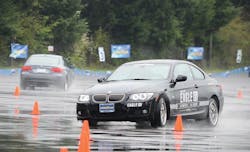Put to the test: Goodyear Eagle F1
Goodyear Tire & Rubber Co. recently conducted a ride-and-drive at Pacific Raceways motorsports park in Kent, Wash.
There, tire dealers and members of the media spent a rainy Washington day learning all about the new Goodyear Eagle F1 Asymmetric All-Season’s wet handling characteristics.
The race-inspired product, which offers strong handling and all-season traction, was introduced at the 2012 Goodyear Dealer Conference in January. It will be available starting in July.
“We apply breakthrough technologies to many tires in our Eagle lineup,” said Jonathan Lee, Goodyear brand general manager. “Fortunately, experts — from third-party product testers to our extensive retail network to everyday consumers — recognize the product leadership and help keep Goodyear Eagles out front.”
The Eagle F1 Asymmetric All-Season is an all-new design, inspired by the complementary summer tire, the Goodyear Eagle F1 Asymmetric 2.
Its asymmetric tread pattern is based on the summer tire, but the Eagle F1 Asymmetric All-Season features a Dry Handling Zone on the outside shoulder for enhanced handling and grip, and an All-Season Zone on the inside shoulder for increased water evacuation. The tire also offers:
• Specialized Tread Compound with Functionalized Polymers — for enhanced performance characteristics, such as wet traction and dry handling;
• TredLock Technology — with microgrooves that provide biting edges for enhanced wet traction;
• Traction Teeth — providing further biting edges for traction in rain and snow.
The Eagle F1 Asymmetric All-Season carries a 45,000-mile tread life limited warranty, will be available with W- and Y-speed ratings, and will be offered in 36 different size combinations.
Targeting balanced performance: capturing the ‘sweet spot’
Tim Lovell, Goodyear’s technical project manager for consumer tires, said that when Goodyear develops a new tire, the tire technology team comes up with performance targets.
In the case of the Eagle F1 Asymmetric, those targets included strength in the areas of tread wear, dry handling, wet handling, wet traction, dry traction, snow traction, ice stopping, ride comfort and noise.
“We aggressively started this project about a year ago,” Lovell explained. “Since it’s an all-season tire, we wanted to test its snow performance. I was able to leverage a lot of different resources across the globe.”
Lovell said his team went to Goodyear’s San Angelo, Texas, proving grounds for wet and dry handling and ride traction testing. At the company’s Akron, Ohio, proving grounds the team did a significant amount of snow testing.
Lovell said to achieve balanced performance with tread wear, his team came up with the asymmetric pattern. To maintain the handling, they looked at the profile of a racing slick. There’s actually a little higher tire stiffness in the shoulder than there is in the sidewall of a racing tire.
“We said we need all-season performance so we can’t have that level of stiffness, but we can capture that profile. That puts in the sweet spot for handling and steering response.”
